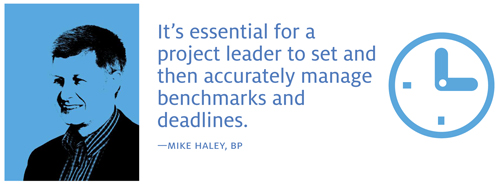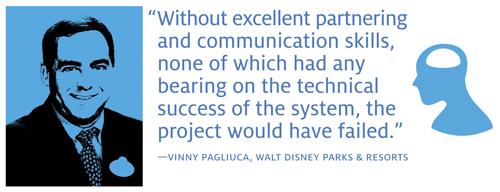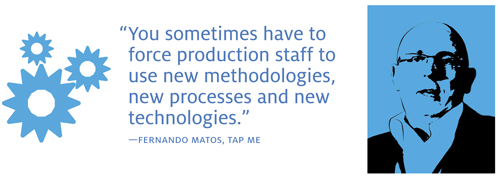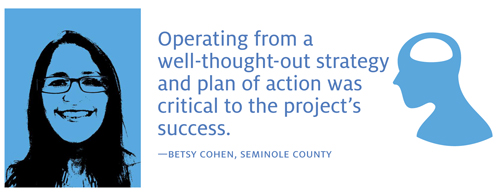It gives our company a competitive advantage. It enables us to track and manage high-value assets or inventory or work-in-process or vehicles or livestock or perishables in transit… It allows us to safeguard hospital employees and patients or assisted-living residents or miners… It boosts productivity and efficiencies. It improves customer service and engenders loyalty. It saves money and delivers a significant return on investment.
“It” is radio frequency identification, and after numerous fits and starts, the technology is now on a steady path to adoption. The predictions of naysayers and skeptics who questioned RFID’s value have been drowned out by published reports from companies across a wide swath of industries that extol the technology’s benefits. In addition, news continues to leak out about companies that have deployed RFID but prefer to stay mum on the subject, precisely because they believe it offers a competitive advantage.

Today, most businesses know what RFID is and what it does. They likely are aware of companies in their industry that are using RFID and what benefits those companies have achieved. This is especially the case in the apparel retail sector, as well as health care and manufacturing. But increasingly companies in other industries—from agriculture to waste management—have proven there’s a business case for adopting RFID. “There is a growing awareness and understanding about the benefits of RFID,” says Michael Liard, an independent analyst and consultant for the RFID industry. “We’ve seen an uptick in deployments across manufacturing, health care, transportation and logistics, and other fields.”
Some may say: “We’ve heard these predictions about RFID before.” It’s true many thought RFID would take off when Walmart, the U.S. Department of Defense (DOD) and others required suppliers to tag shipments. But that didn’t happen. Before the Great Recession, the industry seemed poised once again to take off. Then, the economic downturn caused many companies to rein in spending on IT projects, including RFID pilots and deployments. In some cases, the threat of lawsuits from so-called patent trolls also led to implementation postponements.
But during that time, the RFID industry continued to improve the technology and develop standards, to make it more reliable, robust and easy to deploy. At the same time, when reducing payrolls and eliminating discretionary spending wasn’t enough to weather the recession, some companies turned to RFID and found new efficiencies and cost savings, earning profits even in a sluggish economy.
To achieve benefits from RFID, organizations must still develop a clear deployment strategy—from defining the business case and forming a crossfunctional team to developing training programs and addressing change management (see Best RFID Deployment Practices). “There are a lot of moving parts and a lot of potential use cases,” Liard says. “It’s important to focus on how and where RFID makes sense and provides the biggest returns.”
RFID Can Solve a Problem
One of the key factors in the adoption of a new technology is that it can solve a problem no other technology can solve, according to Geoffrey Moore, author of Crossing the Chasm and Inside the Tornado, two best-selling books that explain how new technologies become mainstream. Companies understand that RFID solves real-world business problems, Liard says.
This is clearly the case with apparel retailers, a sector industry analysts believe will likely be the first to reach the tipping point in RFID adoption, perhaps as early as 2016. “Apparel retailers used to think they didn’t have an inventory problem, until studies conducted at the RFID Research Center showed that RFID could improve inventory accuracy from an industry average of 60 percent or less to more than 95 percent,” says Bill Hardgrave, dean of Auburn University’s Harbert College of Business and founder of the RFID Research Center. “By 2014, it was hard to find a retailer not aware of RFID and its ability to improve inventory accuracy cost-effectively.”
Still, while Kohl’s, Inditex and other major retailers announced RFID deployments in 2104, many companies continued to sit on the sidelines—”that is, until a new problem created a sense of urgency,” Hardgrave says. “Retailers now want to get up to speed quickly to achieve the real-time inventory accuracy they need to deliver an omnichannel shopping experience to customers.”

Companies in other industries also understand that RFID can solve a business problem, says Richard Aufreiter, director of product management identification technologies at HID Global. As a result, he says, “We’re seeing traction in several verticals, such as waste management, health care, automation industry, commercial laundry and even ‘proof-of-presence’ use cases, as in home health-care visit verification or digital marketing.”
For Sanford Health, a nonprofit health-care system operator with locations in 126 communities throughout nine Midwestern U.S. states, lower cost and more comprehensive but streamlined solutions served as the trigger for implementing RFID. In 2014, the health-care provider opened a new “patient-centric” clinic in Moorhead, Minn., that uses an RFID real-time location system (RTLS) to eliminate wait times for examining rooms and to monitor equipment and supplies. Sanford Health is now rolling out the RTLS solutions at two other medical centers.
“In looking at market segments in our patient population, it became evident that efficiency, accuracy and time surrounding a clinic visit are all important aspects to consider when looking at improving satisfaction and quality,” says Jeff Hoss, VP of Sanford Clinic Fargo, which includes the Moorhead site. “Our decision to invest in this technology is based on current applications in asset tracking and a futurist vision of perfecting our patient experience.”
American Woodmark, a Winchester, Va.-based manufacturer of custom kitchen cabinets, deployed RFID across its enterprise to improve inventory accuracy, which is essential to meet its production schedules. In addition to RFID-enabling its plants and warehouses, American Woodmark worked with two domestic and two international suppliers to get them to tag components before shipping. “RFID is now engrained in our manufacturing processes,” says Harry Arose, senior project manager at American Woodmark. “Our people think and talk RFID.”
RFID Gets Easier and Less Risky
RFID is far from plug-and-play, but lessons learned from early adopters, hardware and software product developments, and technology standards have coalesced, so it’s become less risky for organizations to adopt the technology, and they can move forward with RFID projects faster and more efficiently. “We now have standards-based technology across the board—for low-frequency, high-frequency, active and passive systems,” Hardgrave says. “Costs have dropped dramatically and the ROI equation for various applications has been enhanced significantly.”
When a CIO reviews a list of potential IT projects, he or she considers cost/benefit and risks, says Scot Stelter, senior VP of RFID and Internet of Things at ChainLink Research. “In the past, risks such as intellectual property exposure, unclear return on investment and deployment uncertainty often moved RFID projects below the cut line on the priority list,” he says. “The riskissues are behind us. RFID is now on a level playing field with other technologies a CIO could spend money on.”

In addition, Stelter says, RFID is becoming easier to deploy because companies are taking advantage of developments such as cloud computing. “Cloud-based software solutions offer more flexibility and lower IT costs,” he says. “Typically, RFID software platforms have to be customized to integrate with legacy systems, which can be expensive and time-consuming. Cloud-based systems simplify and accelerate this process. Pay-as-you-go software services also reduce up-front costs, making RFID more accessible to projects with limited budgets.”
The RFID industry and customers also understand the capabilities of RFID and the maturity of related solutions better now, HID Global’s Aufreiter says. “The technology is much less ‘mysterious’ and ‘threatening’ than it may have been a few years back,” he says. “What may have once been too ‘cutting edge’ is now mainstream.
“Often potential customers come to a show booth knowing what the technology can and can’t do, and how it may apply to their specific application,” Aufreiter says. “They ask whether we have or can make a tag for their needs. This was not the case a few years back. It’s especially true for RFID shows, not so much in vertical shows.
“Nevertheless,” Aufreiter says, “almost every RFID project presents unique challenges in terms of environment, IT and process integration at the customer’s site. This requires trusted advisors from the RFID industry as well as properly planned pilots from the customer’s side. RFID is rarely an out-of-the-box solution. But RFID providers and systems integrators are quite experienced, and can help customers reduce pilot and evaluation times.”
Still, companies often have to work with several RFID providers to cobble together a system. They may buy readers from one vendor, tags from another and software from yet another. Then, they have to hire a systems integrator to put it all together. One of the goals of the RAIN Alliance, formed in 2014 to promote passive ultrahigh-frequency RFID, is to encourage its members—hardware and software vendors and systems integrators—to work together to offer complete solutions, says Steve Halliday, the organization’s president.
Whether it’s a retail, health-care or manufacturing deployment, following best practices gleaned from early adopters can speed deployments. Detailed project planning and store-specific hardware/software configurations packed in a “golden release” enabled Kohl’s to deploy RFID across its stores in roughly three months, while competitors are taking much longer, says Su Doyle, head of RFID industry programs at OATSystems, a division of Checkpoint Systems, which provided the hardware, software and integration. Methodical planning, she says, eliminates problems and surprises.

What’s more, Doyle adds, “The more involved a retailer’s store operations and training staff are at the ground level, the more successful the project, since the participants have a vested interest in the outcome.” Some retailers are using flagship stores as RFID training facilities, Doyle says. They appoint “ambassadors in each store who are willing to teach best practices for tagging, managing inventory, expediting orders and fulfilling orders,” she says. “They move them from store to store. The approach tends to advance the technology faster and more effectively than if a vendor handles the task.”
Mapping out processes and steps is critical to speed and success, says Hoss at Sanford Health. Roughly 18 months prior to implementing RFID, the firm began identifying scenarios and issues that typically arise when moving patients from one station to another. “We used pencil and paper to identify ideal pathways with little obstruction when patient navigation was reviewed,” he says. “We spent time understanding what milestones in a patient visit are most important to the staff so they could better prepare and predict workflow. Once we completed the task on paper, we applied technology to help us monitor and adhere to our new process flows.”
Once all the technical issues were addressed, Sanford Health began educating staff, doing demonstrations and discussing how the RTLS application would work in practice, Hoss says. “The use of this technology without thorough explanation can leave gaps in understanding,” he explains. “We spent quite a bit of time talking about our intended use, which was to help simplify work. We reframed concerns about tracking employees and focused on tracking events in workflow and how we could intervene earlier to eliminate variation.”
In early 2013, Deere-Hitachi Construction Machinery Corp., a joint venture between John Deere and Hitachi, began considering RFID to track the assembly of construction machinery at its Kernersville, N.C., facility. By year-end, the company had deployed an RTLS that identifies when each excavator passes through a specific zone on its way to the next assembly station. The solution improves visibility into the firm’s work-in-process.
A number of factors were critical to the speed and success of the project, says Dennis Kubica, CEO of Kubica Corp., the Novi, Mich.-based engineering firm that provided systems integration services. “With an RFID solution, there are typically many players involved—from our client’s enterprise teams to subcontractors,” he says. “Each entity has its own needs and interests. Quickly bringing to the collaboration table those needs and interests gets the team working together to solve problems.”
Team members on the Deere-Hitachi project, Kubica says, formed a strong, trusting partnership. They mapped existing business processes and workflows, and then matched the business process change with the right technology. They also assessed vendors and worked with companies that offered scalable base technology that would allow the company to add RFID applications and expand the scope of existing solutions in the future. In order to build a robust RFID platform, he says, companies must “understand the business need and apply the right technology for the solution.”

RFID Delivers Multiple Benefits
RFID is heating up not only among new adopters. Companies that have deployed the technology successfully are now looking for ways to gain additional benefits and expand their use of the technology. This may mean extending it within an organization or into the supply chain. Airbus is doing both.
In 2007, the jet airplane maker announced a three-phase plan to use RFID to gain visibility into operations companywide—from its global supply chain to manufacturing and in-service support processes. Since then, Carlo Nizam, head of RFID and value chain visibility at Airbus, has shared the company’s big-picture approach to deploying the technology, and reported on various initiatives and deployments.
In February, Airbus announced it was entering a new phase: It has asked suppliers to tag all traceable items with passive RFID transponders. Understanding the challenges many of these businesses face, Airbus is offering a high level of flexibility along with consulting and technical support. A key to expanding an initiative and making it work—particularly across a supply chain—is to introduce value for everyone, Nizam says: “For us to succeed, our suppliers upstream need to succeed, and our customers downstream need to succeed.”
RFID providers, such as Hanmi IT and Zebra Technologies, are creating greater confidence in the technology’s benefits by using it internally. In 2011, Smartrac, a Netherlands-based RFID hardware provider, partnered with Vilant, an RFID solutions provider based in Finland, to develop a system to automate shipping processes at Smartrac manufacturing facilities.
The EPC Gen 2-compliant system, which was piloted at a plant in Fletcher, N.C., verifies shipments, improves handling and processing, reduces error rates and lowers overall costs, says Andreas Petrongari, Smartrac’s SVP Corporate IT.
Since then, Vilant has rolled out the solution at Smartrac facilities in Finland and Malaysia. “It’s a turnkey solution,” Petrongari says. “It took us just one week to implement the solution in Malaysia.” Smartrac plans to introduce the technology to facilities in Ayutthaya, Thailand, and Dresden, Germany, soon.
Retailers are also expanding and entering new phases of their deployments, many to support omnichannel initiatives. Marks & Spencer, for example, has moved beyond tagging apparel items at all its stores. The British retailer is now using RFID to track and manage all general merchandise.
Macy’s and Bloomingdale’s have been RFID-tagging replenishable apparel and footwear items at 850 stores, to ensure they are on store shelves when shoppers want to buy them. Now, Macy’s is beginning to tag nonreplenishable fashion items, to make sure the merchandise is on the sales floor, which could reduce the need for markdowns.
Retailers that have been using RFID to improve inventory accuracy now want to build on that foundation to achieve other benefits, Hardgrave says. They are interested in what the RFID Research Lab calls second-order (SO) use cases, such as enhancing the customer experience and loss prevention. Another SO use case is distributed order management, which addresses whether to source goods directly from the supplier, the back room of a store or a distribution center. As retailers develop an omnichannel strategy, Hardgrave says, the source decision must be optimized and made in real time.
Royal Caribbean has been steadily adding RFID applications since it first deployed the technology in 2009 on its Oasis of the Seas cruise ship, to enable families and tour groups to track their members. The following year, Royal Caribbean introduced RFID-enabled self-service soft drink machines on the Majesty of the Seas, which eliminated long waits at the bar and boosted sales for the company. It was such a hit that the company decided to roll out the drink dispensers to its entire fleet. And since 2014, passengers on its newest cruise ship, Quantum of the Seas, receive RFID wristbands, which they can use to pay for food, drinks and services, and to unlock their stateroom doors. In addition, the company introduced an RFID solution that lets passengers keep track of their luggage. “Guest convenience is number one,” says Royal Caribbean CIO Bill Martin.
RFID—It’s All About Value
The perception that RFID adoption has been growing in fits and starts is due mainly to all the attention paid to retail, where progress has been dominated by just a few players like Walmart, ChainLink’s Stelter says. “The reality is that RFID has been seeing steady growth as companies in multiple verticals move from awareness of the technology to consideration, evaluation, negotiation and deployment,” he says. “We’re not only seeing this progression in large industries, such as manufacturing and health care, but in smaller sectors, such as law firms and libraries.”
Now that the retail industry is embracing RFID, it’s driving awareness in nonretail sectors, Stelter says. “When Macy’s announces the benefits it is achieving from RFID,” he says, “all retailers—as well as firms in other industries—pay attention.”
While retailers may be garnering the headlines, companies in other industries have been exploring, piloting and deploying RFID for years, says Robert Zielinski, director of commercial marketing at systems integrator CDO Technologies. “Today, more organizations are looking at more applications to drive value,” he says. “RFID is coming out of stovepipe mode, in which companies deployed an application to track work-in-process or inventory, and entering blanket mode, in which RFID provides visibility across the enterprise. Now they have an intelligent organization.”
One CDO client, a global manufacturer of consumer packaged goods, deployed an RFID system to reduce waste and got what Zielinski calls “a surprise byproduct.” The system “eliminated quality incidences—the company went from about a dozen quality issues a year to zero,” he says. “So while they are very excited about the improved efficiencies on the manufacturing floor, they have a new reason to look at RFID and are now implementing it at other facilities.”
And it’s not just large manufacturers that are exploring RFID, Zielinski adds. “We recently worked with a small repair shop for retailers with 53 employees,” he says. “They’re using RFID to provide visibility into workflow, automate batch processes and automate finish-goods shipping.”
CDO is seeing an “explosion” in RFID adoption, Zielinski notes. “In the first two months of 2015, CDO’s RFID contracts are up 409 percent from the same period last year,” he says. “And last year was more than double the year before. The customer is out looking for information about RFID.”

